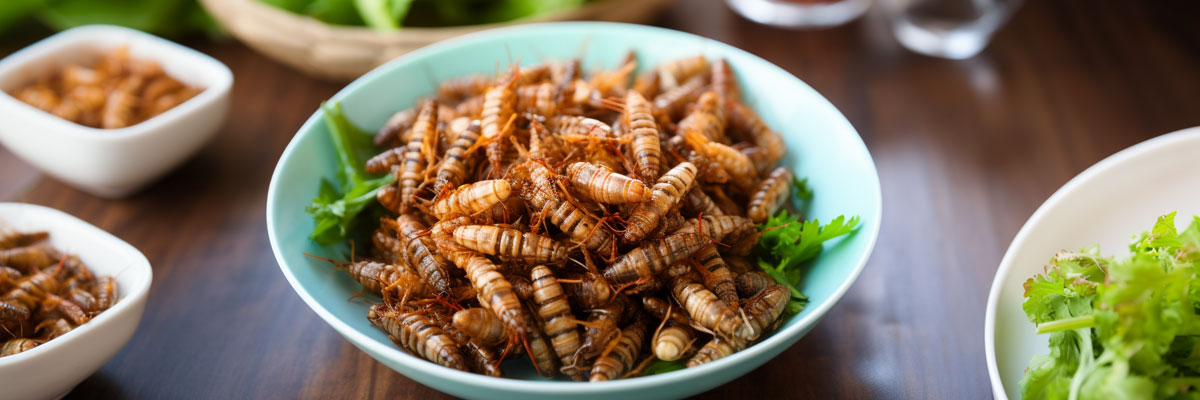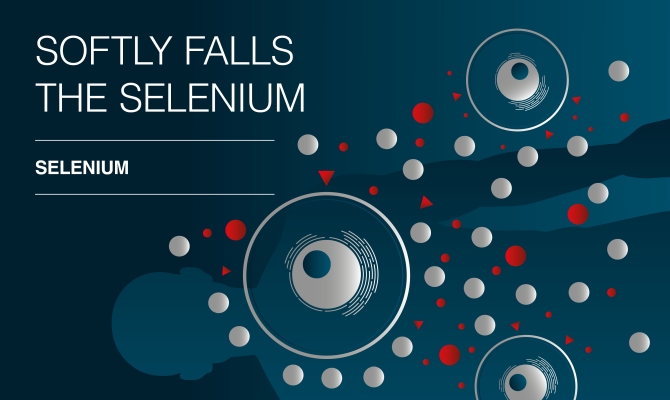
Insects – a useful addition to the menu?!
Burgers made from insects instead of minced beef? If you ignore the culturally determined “yuck factor”, there are many arguments in favour of integrating these little suppliers of energy into your diet. Read on to find out what insects can offer besides protein, and to learn about the EU’s legal framework for approving insects as food.
The world is not going to get any bigger, but its population will continue to grow in the coming decades. By 2100, it is estimated that there will be over ten billion people living on Earth. This means an additional two billion more people who will need to be fed [1]. This is a challenge that will either require new methods and more equitable distribution of food – or new food sources.
“Novel Food” is the term used for the latter, and one which covers a range of strategies to counter growing world hunger. It refers to any “food that had not been consumed to a significant degree by humans in the EU before 15 May 1997” [2]. This includes food from cell or tissue cultures (e.g. laboratory meat grown in vitro), food from microorganisms, fungi, algae, or even from animals that have not previously been consumed in Europe, such as insects. But can our little six-legged friends make a significant contribution to supplying the population with nutrients in this part of the world?
The legal framework for eating insects has been defined
Although viewed with great scepticism by consumers in Europe, insects have long been part of the culinary culture in Asian countries. Insects in various forms are part of the menu there, just like bread and potatoes are in the West. Since 2015, the European “Novel Food Regulation” [3] and, since 2018, the “Implementing regulation on the procedural steps of the consultation process for determination of novel food status” [4], have legally paved the way for food made from insects or insect components to be brought onto the market in this country as well. Since then, four species have received approval as food under the Novel Food Regulation, mostly in frozen or dried form [5].
- Larvae of the yellow mealworm beetle (Tenebrio molitor), better known as mealworms – 22nd June 2021
- Migratory locust (Locusta migratoria) – 5th December 2021
- House cricket (Acheta domesticus) – 3rd March 2022
- Larvae of the litter beetle (Alphitobius diaperinus), also known as the lesser mealworm – 24th January 2023
How an insect becomes food
In order to approve a new food, such as a new insect species, under the Novel Food Regulation (Regulation (EU) 2015/2283) [3], an application must be submitted to the European Commission. This application must include data on the composition, manufacturing process, and planned use of the product, as well as scientifically based data on the nutritional, toxicological and allergenic properties. The European Food Safety Authority (EFSA) checks the safety of the proposed product. If this can be assured, the EU Commission can decide on approval, but only if the member states agree. The approval is then valid exclusively for the applicant for five years. After this period, competitors will also be permitted to market the product [5,6].
Further information about the Novel Food Regulation and the approval process can be found on the European Commission website: https://food.ec.europa.eu/safety/novel-food/legislation_en
Why should we give insects as food a chance?
From a nutritional point of view, insects are valuable sources of protein that are very much the equal of meat products. Crickets, for example, contain around 20 percent protein when fresh, and between 50 and 70 percent when dried [7]. For comparison, fresh beef contains around 25 percent protein, or 55 percent as dry matter.
The mealworm is also a valid alternative to meat in this respect. One hundred grams of dried mealworm larva contains around 50 grams of protein. In addition, mealworms generally have a higher vitamin content than beef [8]. An exception is vitamin B12, which is only found in animal food sources, and is present in mealworms at a significantly lower concentration than in beef (0.5 µg/100 g compared to around 3 µg/100 g) [8]. In this respect, crickets, which are also already approved as food in Europe, score higher, with a vitamin B12 content of over 5 µg/100 g.
While the vitamin B12 content varies between species, insects can be classified as nutritionally valuable because, in addition to proteins, they provide large amounts of omega 3 and 6 fatty acids, trace elements, and minerals such as magnesium and phosphorus, as well as a wide variety of amino acids. Mealworms, for example, are characterised by a high methionine content [7], and the content of other essential amino acids such as leucine, valine, tryptophan and threonine is comparable in beetles to the levels in fish meal. In the case of phenylalanine, the amino acid content of insects is actually significantly higher. A paper from the consumer advice centre in Hamburg provides a good overview of the nutritional values of insects [9].
The environment is also another good reason for incorporating insects into the daily diet. They require less space and feed per kilogram of food produced, which means they have a lower CO2 footprint, and are also more fully usable. With cattle, only around 40 percent of the animal ends up on the plate; with grasshoppers, around 80 percent of the animal can be eaten [10]. In addition, insects can currently be bred without the use of antibiotics, other medications, or chemicals.
Potential for allergic reactions and other risks
However, there are disadvantages and risks of using insects as food that should not be ignored. Previous research suggests that Insecta can cause allergic reactions in a similar way to Crustacea. This is not entirely surprising, since both (along with the Chelicerata – arachnids, scorpions, mites, etc.) belong to the phylum Arthropoda (arthropods). The main allergens are the proteins tropomyosin and arginine kinase [11]. The allergenicity of these proteins remains even after thermal treatment, which is why anyone with a known shellfish allergy is advised not to consume insect products for safety reasons.
For this reason, food made from insects or containing added insects is subject to strict labelling requirements. Firstly, the insect species used must be stated in the list of ingredients. An example of this would be: “partially defatted powder obtained from Acheta domesticus (house cricket)” or “frozen/paste Alphitobius diaperinus larvae (lesser mealworm)”. Secondly, there must be an allergy warning on the product that warns consumers with pre-existing allergies to crustaceans, molluscs or house dust mites [5]. According to EU Regulation 2023/5, this warning must be stated directly in the list of ingredients.
While allergenicity tends to affect a small group of consumers, there is also a general risk of emerging zoonoses when using insects as food, i.e. the transmission of animal diseases (such as those caused by viruses) to humans. According to the consumer advice centre in Hamburg, these are unlikely, but there has still not been sufficient research into communicable diseases in farmed insects [7].
In basic terms, the wealth of experience and guidelines gathered over decades of factory farming mammals, birds and fish are yet to be replicated in the field of insect breeding. Although breeders in Europe highlight the fact that insects have so far been bred without the use of antibiotics or other chemicals, there are currently no specific requirements for the breeding of food insects [11].
Insects as a food of the future?
The role that insects will play in the European diet in the future will not depend solely on consumer acceptance. Their introduction could most likely be achieved through careful inclusion, for example in processed products that contain insects as just one of many ingredients that require labelling. But the legal requirements for insect breeding for the food sector, as well as the research work on ingredients and potential risks, are also important factors in making greater use of this branch of nutrition, which has scarcely been developed in Europe.
Three food additives that have long been made from insects (or insect products)
Many Europeans certainly react with disgust when it comes to eating insects. But additives made from processed insect parts or products have long been an integral part of food production [5]:
-
- Cochineal (E 120): This natural red food colouring is obtained from dried female cochineal scale insects and can be found, for example, in chocolate lentils and soft drinks.
-
- Shellac (E 904): This natural release agent and coating material comes from the resinous excretions of the lac beetle, and is often applied as a protective layer to fruits such as apples, melons or citrus fruits.
-
- Beeswax (E 901): Beeswax is another product that comes directly from insects and, in addition to being used as a coating material, is also permitted as an opacifier in lemonades.
Another important point is that, despite the greatest possible caution, it is always possible that insect components are being incorporated into the processing of natural foods. The US Food and Drug Administration (FDA) has seemingly surprisingly high limits for this. In the USA, up to 225 insect parts per 225 grams of pasta are permitted for pasta products (i.e. 1 part per gram). For chocolate, the limit is up to 74 insert parts per 125 g. And ground pepper can even contain up to 475 insect parts per 50 grams [11].
Sources:
[3] https://eur-lex.europa.eu/legal-content/DE/TXT/?uri=CELEX:32015R2283
[4] https://eur-lex.europa.eu/legal-content/DE/TXT/?uri=CELEX%3A32018R0456
[5] https://www.lebensmittelverband.de/de/aktuell/insekten-in-lebensmitteln-das-muessen-sie-jetzt-wissen
[6] https://germany.representation.ec.europa.eu/insekten-lebensmitteln-die-fakten_de
[8] https://www.fao.org/3/i3253e/i3253e.pdf (S. 70 ff.)
[11] https://food.r-biopharm.com/de/news/essbare-insekten-delikatesse-oder-allergierisiko/



